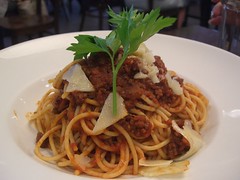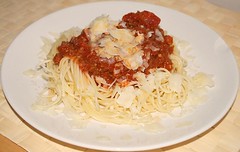This is the way it's called all over the world even though we call it in Italy "Pasta al ragù" (the ragù is "alla bolognese").
It's mainly made of tomato and minced meat BUT not only of that (and this is basically the difference between the one you find in "JukkaPekka's restaurant" and a proper italian one).
INGREDIENTS for 4 persons
- 1/2 onion
- 1 carrot
- a bit of persil
- 1 glass of red wine
- salt
- extravirgin olive oil
- 1.6Kg of sleeved tomatoes
- 0.4 Kg of minced meat (naudanjauheliha)
PREPARATION
Slice carrot, onion and celery in thin slices. Put 1 dl of oil into a casserole just to cover the bottom and put the carrot onion persil and celery in. Start frying at low temperature until the onion gets yellowish.
Then throw the minced meat in and cook until it gets brown. At that point put the red wine and let evaporate.
Now it's time to raise the temperature and to put the tomatoes that you previously slightly pressed.
Add 1-2 dl more of oil if needed and cook for 30/40 minutes (this would pretty much depend on the temperature you are cooking at) stirring regularly. You will understand that it's done when the sauce reduced its quantity to half of the original one. At that point the meat will be 50% of the tomatoes (you started at 25%).
Add salt as you like.
Cook the pasta now and take it out one minute before you usually would and finish cooking it in the sauce.
Add parmigiano in big quantity.
Enjoy.
 Image by avlxyz via Flickr
Image by avlxyz via Flickr
 Image by 1JLS via Flickr
Image by 1JLS via Flickr
![Reblog this post [with Zemanta]](http://img.zemanta.com/reblog_e.png?x-id=7a215adc-fbd7-43d1-96e3-3971267543b1)


![Reblog this post [with Zemanta]](http://img.zemanta.com/reblog_e.png?x-id=c95285ab-b596-494f-93b7-d2116dba4c04)